






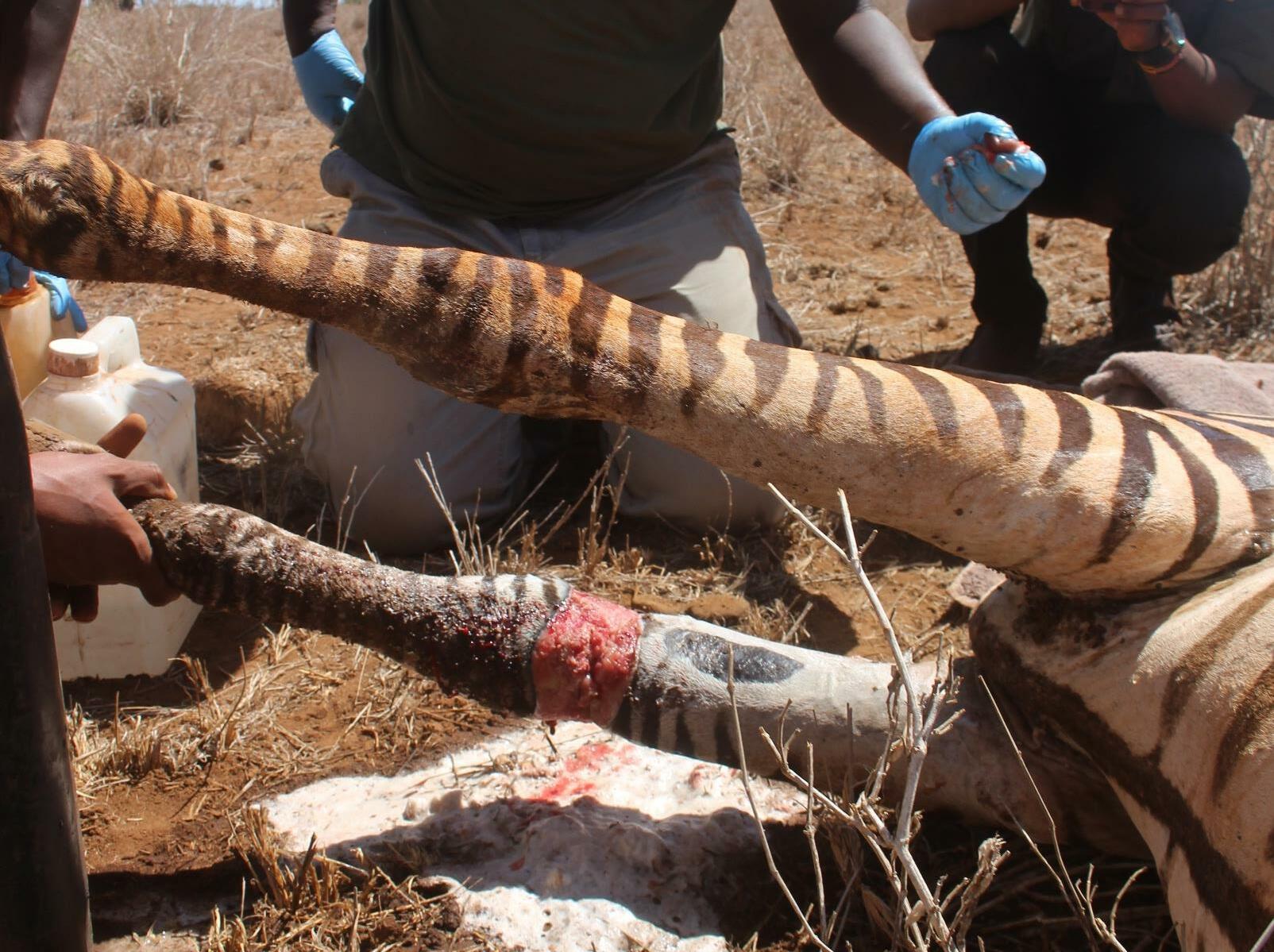
 November
November

The Tsavo Conservation Area received moderate rainfall at the beginning of November with good precipitation experienced towards the end of the month. Presently, there is adequate forage for browsers and grazers to utilize, rivers are flowing and dams in the area have been filled to the brim. The SWT – KWS Tsavo Mobile Veterinary Unit attended to 15 cases in November, 10 cases of these cases involved elephants while 4 cases in total were related to poaching. Among other interventions, the Veterinary Unit rescued 2 weak and emaciated elephant calves on separate occasions, and rescued an adult female elephant found trapped in a drying water dam just outside Kulalu ranch.
The Tsavo Mobile Veterinary Unit would like to thank all stakeholders who reported wildlife cases requiring veterinary intervention. The Veterinary Unit is also grateful for the on-going financial support received from Vier Pfoten through the Sheldrick Wildlife Trust and the technical support received from KWS management.

Date
Species Area Found
03-Nov 22 Elephant Tsavo West N.P. Rescue Extremely weak male elephant calf seen recumbent near Kilaguni Lodge. Task successful
03-Nov 22 Eland Kaluku –SWT HQs Natural Causes Adult female eland with a swelling at the mid-thigh region on the right hind leg. Successfully treated
04-Nov 22 Zebra Taita Sisal Conservancy Natural Causes Adult male zebra was seen limping. Successfully treated
04-Nov 22 Zebra Taita Saltlick Conservancy Snared Adult female zebra with a tight wire snare around the right carpal joint. Successfully treated
05-Nov 22 Elephant Galana Conservancy Snared Young elephant bull seen with a wire snare around the neck Task successful
05-Nov 22 Elephant Kulalu Ranch Rescue Adult female elephant found trapped in a drying water dam just outside Kulalu ranch Task successful
06-Nov 22 Elephant Sala – Tsavo East N.P. Natural Causes Big elephant bull, later identified as Balachu, seen recumbent by air patrol teams Died
07-Nov 22 Waterbuck Voi gate –Tsavo East Snared Adult female waterbuck seen with a tight wire snare around the neck Successfully treated
07-Nov 22 Elephant SWT Voi Stockades Natural Causes Ndotto, a male elephant orphan, had a small stone stuck in one of his nostrils Successfully treated
20-Nov 22 Bushbuck Kaluku –SWT HQs Natural Causes 2-weeks-old baby bushbuck attacked by a baboon Successfully treated
21-Nov 22 Elephant Kulalu Ranch Arrow Adult elephant bull seen with 2 wounds on the left side of the abdomen. Successfully treated
28-Nov 22 Elephant Taita Ranches Postmortem An elephant bull that was reported to be a frequent raider of grain stores found dead. Died
29-Nov 22 Elephant Tsavo East N.P. Natural Causes Adult female elephant seen lying on its right side and struggling to stand Successfully treated
30-Nov 22 Elephant Tsavo East N.P. Natural Causes Adult female elephant seen lying on its left side and struggling to stand. Task successful
30-Nov 22 Elephant Tsavo East N.P. Rescue 1-year-old female elephant calf with a weak, emaciated, and recumbent mother. Task successful





Tsavo West Management informed the Veterinary Unit of an extremely weak male elephant calf (approx. 4 weeks old) seen with its mother near Kilaguni Lodge in Tsavo West National Park.
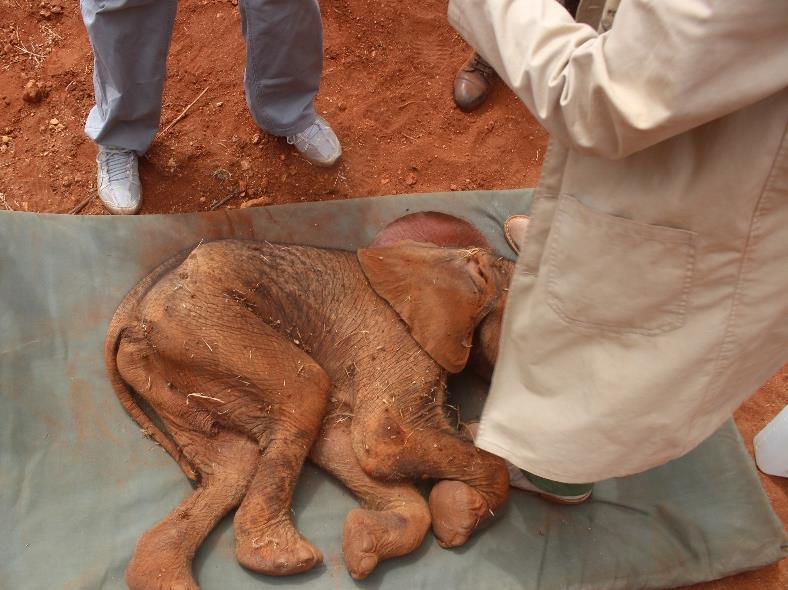
The mother was extremely aggressive and displayed an amazingly strong bond with her weak laterally recumbent calf The mother was darted from a vehicle with 20 mgs Etorphine so the team could have access to the calf. The mother was fully anaesthetized after 7 minutes a few meters away from the calf. The calf was extremely weak, it had a weak heartbeat, slowed breathing rate and pale mucous membranes which are signs of extreme dehydration. The calf was quickly placed on a mat and given intravenous fluids as its body was cooled with water. As this was happening, the mother was monitored and examined. The mother was in good health, but the extreme drought had led to a poor body condition estimated at 2.5/5 where 1 is poor and 5 is good. The calf had to be rescued since the mother could not support the calf in her condition; the calf was taken to the SWT Kaluku stockades for further care and rehabilitation.

SWT management reported that an adult female eland which had been orphaned, rescued and hand raised at Kaluku had developed a swelling at the mid-thigh region on the right hind leg.
The hind limb was clearly swollen with mild lameness observed, but she could put some weight on the leg while moving. There was a partially ruptured abscess on the same leg The eland was approached on foot and darted with 6 mg Etorphine and 80 mg Azaperone. It took 10 minutes for the drugs to take full effect. The wound was surgically opened further and flushed with Hydrogen peroxide. It was then rinsed with water and disinfected with Iodine. Broad spectrum antibiotics and anti-inflammatories were then given parenterally before anaesthesia was reversed with 24 mgs Diprenorphine hydrochloride given intravenously through the jugular vein. She woke up immediately and joined her close friend, a hartebeest, who had stayed close by all through her treatment
The eland has a good prognosis.

The zebra was found alone some distance away from the rest of the herd, it was walking with a limp on the left forelimb. It appeared restless and continuously moved when approached. Restraint was achieved with 5 mgs Etorphine hydrochloride and 60 mgs Azaperone tartarate. The zebra was darted from a vehicle with the drugs taking 4 minutes to take effect. 3 fresh wounds were observed around the coronate of the left forelimb, the cause of these injuries could not be determined. The wounds were cleaned with water, disinfected with Iodine then Tetracycline antibiotics and Flunixin meglumine anti-inflammatories were administered parenterally. Anaesthesia was reversed with 18 mgs Diprenorphine hydrochloride given intravenously through the jugular vein. The zebra stood up 2 minutes post-reversal and run away.
The zebra has a good prognosis.
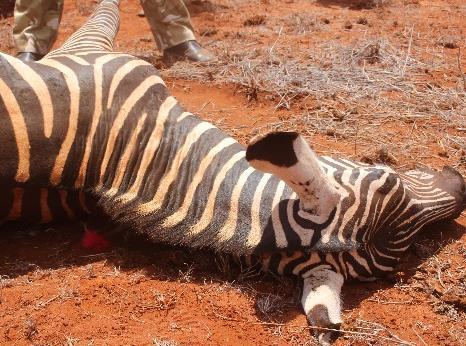
Rangers at the conservancy saw this adult female zebra limping and informed the Tsavo Mobile Veterinary Unit. The zebra had a tight wire snare around the right carpal joint.
After a long search, the female zebra was found a few meters away from a dazzle of zebras. The animal was darted from a vehicle with 5 mgs Etorphine and 60 mg Azaperone delivered with a Daninject dart. The tight snare, which had gorged out a significant amount of muscle tissue, was removed then the wound was debrided with Hydrogen peroxide, rinsed with water, disinfected with Iodine and packed with green clay. Parenterally, Oxytetracycline broad spectrum antibiotics and Flunixin meglumine anti-inflammatories were administered then anaesthesia was reversed with 18 mgs Diprenorphine hydrochloride injected via the jugular vein. The zebra woke up 2 minutes post-reversal and joined the herd.
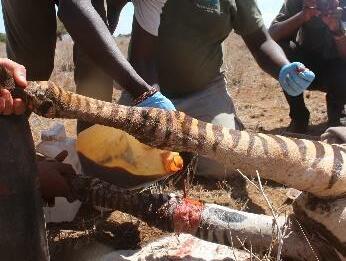

The zebra has a good prognosis.

While on routine daily patrol, the SWT aerial patrol team saw this young bull with a snare around the neck in the evening hours of the day preceding intervention. It was too late to attend to the elephant that day therefore a team was tasked with closely monitoring it so it could be located the following day.
The snared elephant was found the following morning with a small family a short distance away from where it was originally seen. The young bull had a loose wire snare around the neck, otherwise the elephant was in good body condition. The elephant was darted from a helicopter with 12 mgs Etorphine hydrochloride delivered with a 3 ml Daninject dart. The drugs took full effect with the elephant assuming right lateral recumbency. The snare was removed, and thankfully no injuries were observed on the surrounding tissue; no further treatment was required. Anaesthesia was thereafter reversed with 36 mgs Diprenorphine hydrochloride delivered through a prominent ear vein. The elephant woke up 2 minutes post-reversal and moved towards the elephant family.

The young bull has a good prognosis.
KWS officers and members of the community alerted the mobile veterinary unit about this adult female elephant that was found trapped in a drying water dam just outside Kulalu ranch.

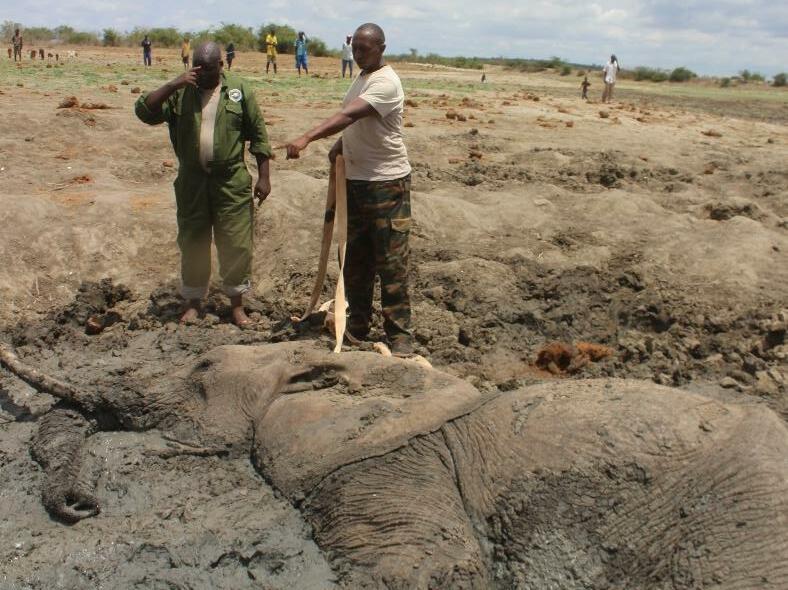

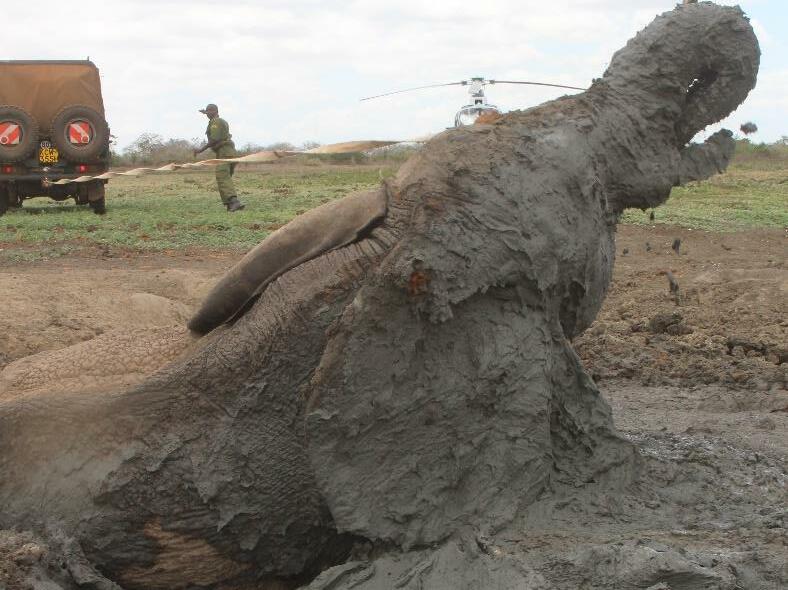
The adult elephant cow was found exhausted and helplessly stuck in the mud after having struggled to free itself for a while. The teams used long ropes and two vehicles to pull the elephant out of the mud. This herculean task took a while and after the elephant was freed, it was given some time to rest and regain enough strength to stand. The elephant was then assisted to to its feet with straps and once it was on all fours, it took off to a nearby thicket.
The elephant has a good prognosis.
This big elephant bull, later identified as Balachu, was seen recumbent around the Sala gate area by air patrol teams who notified the Tsavo Mobile Veterinary Unit.
The big bull was found recumbent and not struggling much to get back on all fours. The elephant appeared emaciated and dehydrated, he had a telemetric collar and was positively identified as Balachu. Balachu was given Dexamethasone anti-inflammatories intravenously before being given several litres of Dextrose and Ringer’s lactate drip. This did not help, and sadly Balachu passed away a few hours into treatment.
Balachu is one among several elephants that have died from the drought ravaging the Tsavo Conservation Area and other parts of Kenya. His tusks and collar were removed and handed over to KWS security for safe custody and accounting.

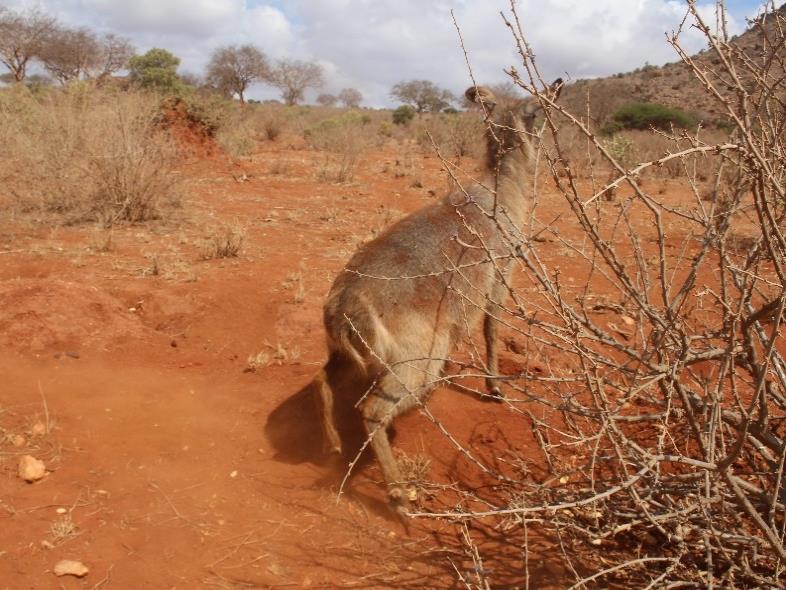

As the Tsavo Mobile Veterinary Unit team approached Voi gate, they spotted this shy and elusive adult female waterbuck crossing the road; the waterbuck had a tight wire snare around the neck.
The waterbuck was darted with 8 mgs Etorphine and 70 mgs Azaperone. The drugs took effect 8 minutes later with the waterbuck assuming sternal recumbency. The animal had a tight plain wire snare around the neck, it is likely that the waterbuck had been targeted by bushmeat poachers. The snare was removed then the abrasion wound was treated with topical Oxytetracycline antibiotic spray. Additionally, Oxytetracycline antibiotics and Flunixin anti-inflammatories were administered parenterally. Anaesthesia was reversed thereafter with 24 mgs Diprenorphine hydrochloride injected into the jugular vein. The animal stood up 2 minutes post-reversal and joined a nearby herd


The waterbuck has a good prognosis
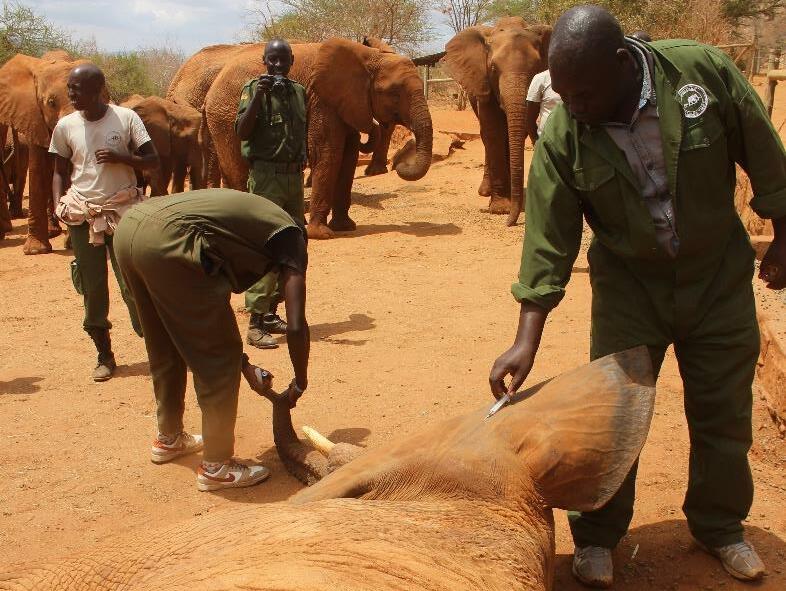

While on routine inspection of the elephants, the stockade manager discovered that Ndotto had a small stone stuck in one of his nostrils. Hardly a month had gone by since he found himself in a similar predicament.
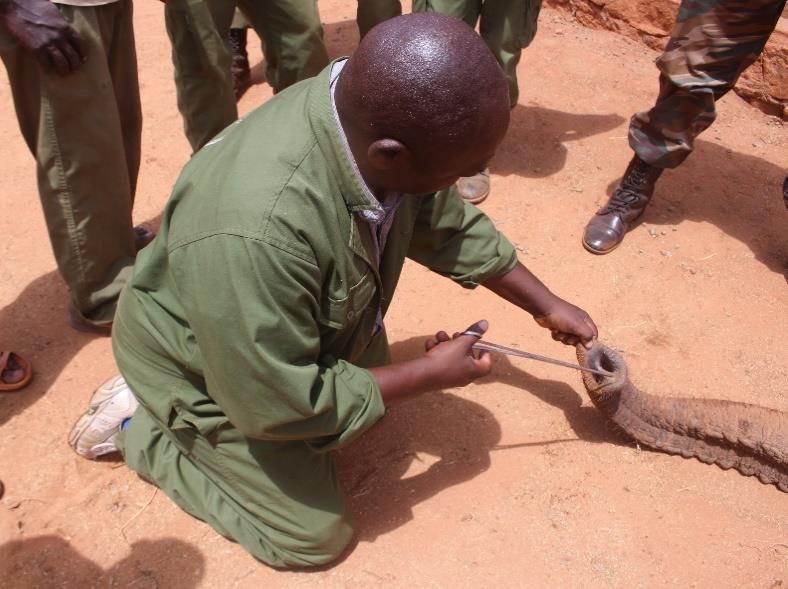
Ndoto was approached on foot and darted with 7 mg Etorphine hydrochloride. The young bull assumed right lateral recumbency when the drugs took effect 7 minutes post-darting Upon physical examination, a small stone was seen in his right nostril about 35 cm from the exit. The irregularly shaped stone was gently grasped with long forceps and pulled out. He was given Oxytetracycline antibiotics and flunixin meglumine antiinflammatories parenterally then anaesthesia was reversed with 80 mgs Naltrexone administered through a prominent ear vein. He stood up 2 minutes post-reversal and joined the orphan herd that was waiting nearby

Ndotto has a good prognosis.
This 2-weeks-old baby bushbuck was attacked by a baboon in Shimba Hills National Reserve, it was rescued the night before and taken to Kaluku for treatment and rehabilitation.
The kid was weak and had lost a lot of blood. Most of the perineal tissue had been ripped off by the baboon, the anal sphincter muscles had been damaged and part of the rectum had been exposed. Under local anaesthesia, reconstructive surgery was attempted. The rectum was put back into position then systemic antibiotics and anti-inflammatories were administered. Topical antibiotics were also applied on the wound.

The kid has a guarded prognosis. The damage to its sphincter muscle and the partial loss of its rectal tissue will greatly compromise its lower gastrointestinal functions.
The big elephant bull was spotted from the air by an SWT pilot on routine patrol, the bull had 2 wounds on the left side of the abdomen.
After a long search, the bull was found browsing among a massive herd of elephants. It was darted from a helicopter with 20 mg Etorphine, and 9 minutes later the drugs had taken effect with the elephant assuming left lateral recumbency. Since the wound was on the left side, the bull was turned over for ease of treatment. Two tennis ball sized wounds were observed on the left lateral side of the abdomen, both wounds had formed draining abscesses and the slightly larger abscess was deeper. An incision was made on the deeper wound to facilitate flushing and later drainage. Both wounds were flushed with Hydrogen peroxide, rinsed with water, disinfected with Iodine and infused with Cloxacillin antibiotic ointment. Amoxicillin antibiotics and Flunixin meglumine anti-inflammatories were then administered parenterally before anaesthesia was reversed with 180 mgs Naltrexone given through a prominent ear vein. The bull rose 2 minutes post-reversal and re-joined the elephant herd.

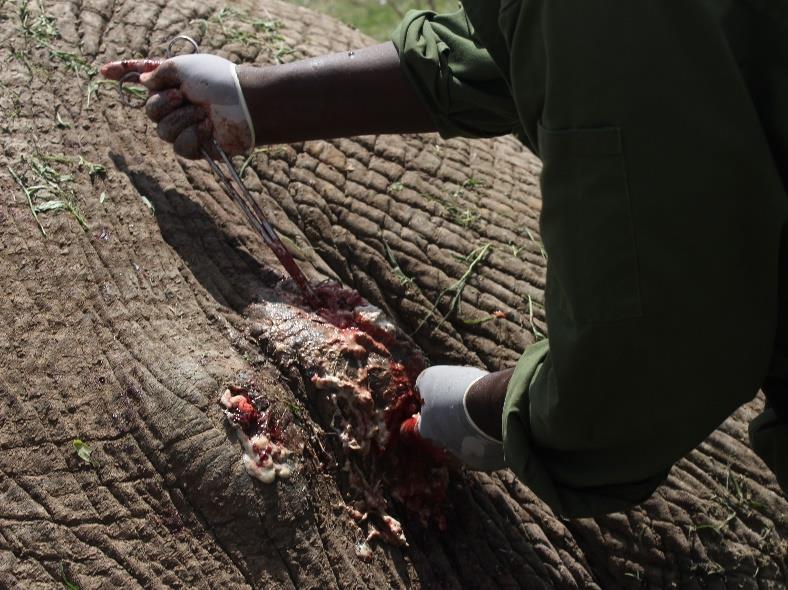

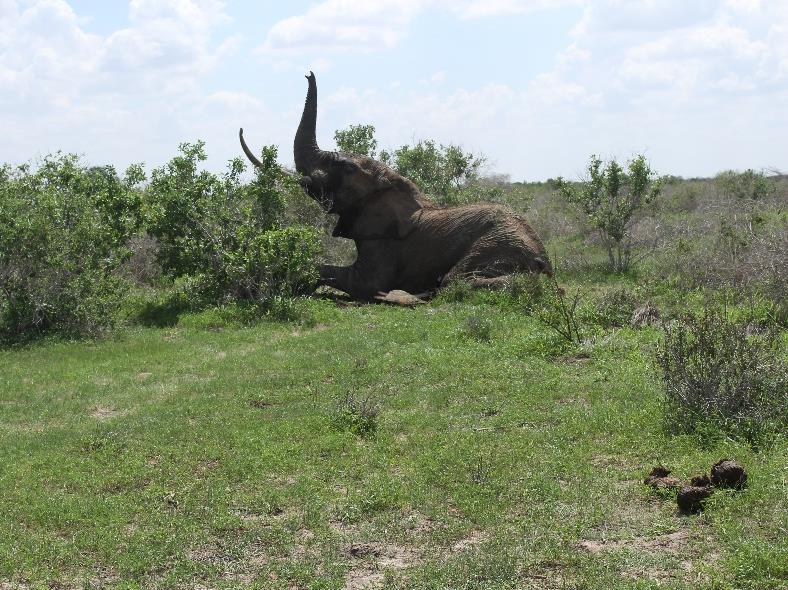
The elephant bull has a good prognosis
An elephant bull that was reported to be a frequent raider of grain stores in human settlement areas was found dead in the morning hours. KWS patrol rangers requested the Tsavo Mobile Veterinary Unit to carry out an autopsy to establish the cause of its death. The elephant was reported to have been trumpeting loudly in distress the evening before it died.


The bull was found in left lateral recumbency, it was extremely bloated, and at the scene there weren’t significant signs of struggle before death. The elephant seemed to have been in good body condition before death. Scanty mucoid anal discharge was observed. No external injury was seen on the carcass.
▪
The lungs were slightly edematous with scanty froth.
▪ The liver had a cooked appearance, thought to be normal pathological changes due to autolysis.
▪ Kidneys looked okay.
▪ The mesentery appeared slightly congested at the level of the large intestines.
▪
The whole GIT had ballooned and was gas filled.
▪
The small intestines appeared twisted and displaced to the inguinal region causing obstruction and interference of bowel movements.
The elephant died naturally from acute intestinal torsion.


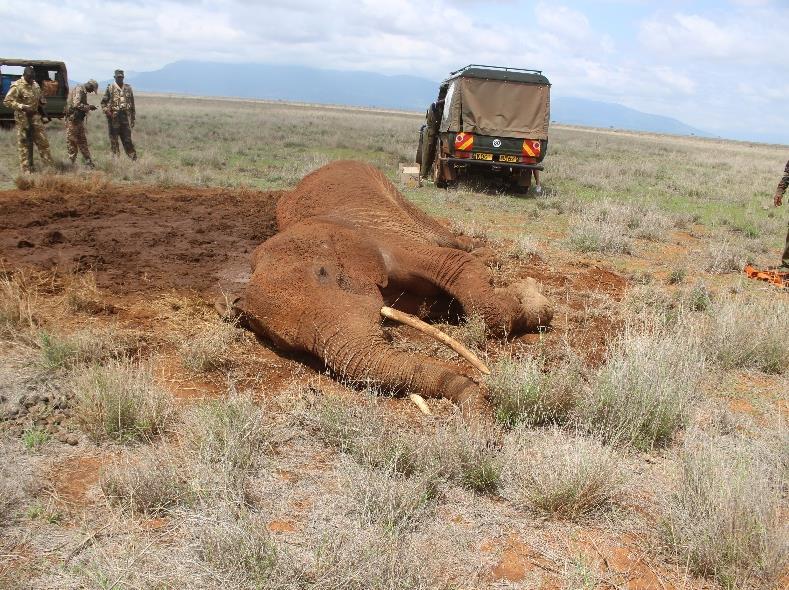
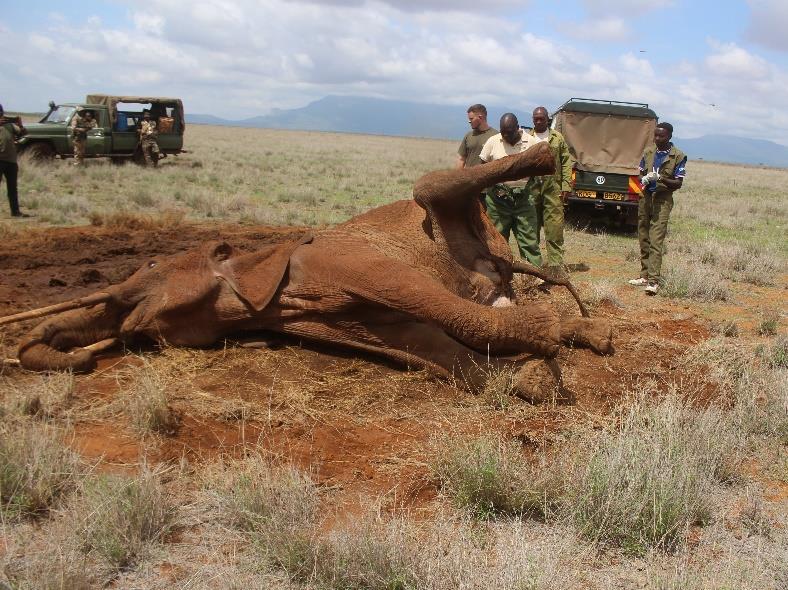
This adult female elephant was spotted from the air by a pilot on routine patrol, it was lying on its right side and struggling to stand.
The female elephant was found lying on its right side and struggling to stand. According to the vet, the elephant may have been in this position for about 48 hours. The elephant was weak, but it was still able to raise its head and move all its limbs. It appeared emaciated with a body score of 2.5 out of 5 where 1 is poor and 5 is good. An abscess was observed at the base of the tail. The elephant was given systemic antibiotics, anti-inflammatories and multivitamins then the wound was flushed with Hydrogen peroxide, rinsed with water and disinfected with Iodine. Topical antibiotic spray was also applied. Thereafter, the elephant was supported to stand and once it was on all fours, it walked away into the wild.
The elephant has a fair prognosis

An adult female elephant was spotted from the air by pilot on routine patrol, the elephant was lying on its left side and struggling to stand.
The elephant cow was found lying on its left lateral side with an adult bull standing close by. The recumbent elephant had a calf (approx. 1-year-old) that was visibly stressed by the ordeal. The calf was standing nearby, but it followed the bull when the veterinary team approached. The elephant cow appeared weak, but it was trying to stand. The veterinary unit pulled the recumbent elephant up, and it managed to stand and walk towards the other elephants
The small female calf was rescued and taken to the SWT Voi Stockade since it was obvious that the mother could not support it.
The mother has a fair prognosis. However, the calf has a poor prognosis since it was emaciated and weak.